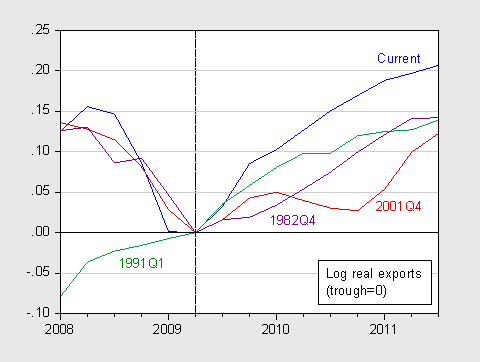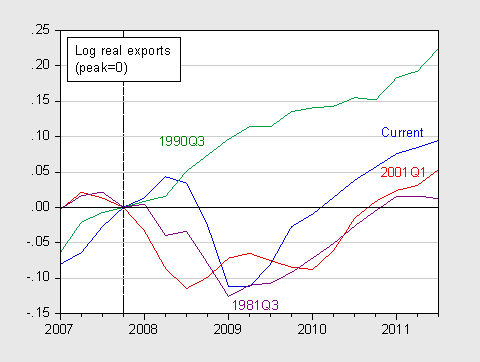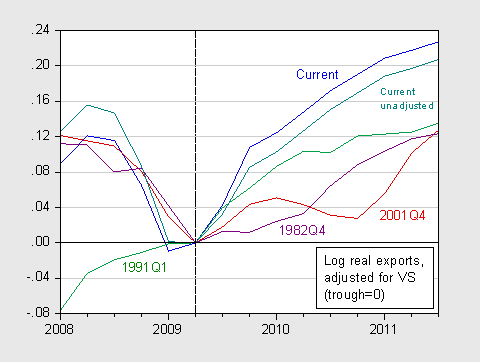Following up on my previous post on the export contribution in the recovery (averaging 2.6 ppts since the trough), here are some additional observations. First, export growth in the current recovery has been substantially greater from the trough than in the last three recoveries.

Figure 1: Log real export growth relative to NBER trough. Source: BEA, 2011Q3 advance release, NBER, author’s calculations.
Second, this characterization is less pronounced, but not overturned, once one takes into account the severity of the drop-off in exports during the recession. (And is less than that observed in the recovery from the 1990Q3-91Q1 recession).

Figure 2: Log real exports relative to NBER peak. Source: BEA, 2011Q3 advance release, NBER, author’s calculations.
Third, export growth has been substantially greater than in the past three recoveries even after accounting for the fact that there is some import content in US exports (vertical specialization). In fact, since vertical specialization declined in 2009, then exports adjusted for vertical specialization have rebounded even faster than unadjusted.

Figure 3: Log real exports relative to NBER trough, accounting for vertical specialization/production fragmentation, using estimates from Johnson and Noguera (forthcoming), interpolated using quadratic match. Source: Source: BEA, 2011Q3 advance release, NBER, Rob Johnson, author’s calculations.
Here I am using adjusting the standard series using estimates provided by Rob Johnson. This is related to work by Johnson and Noguera forthcoming in JIE. (Since the adjustment factor is available only up through 2009, I use assume the factor at 2009 levels thereafter). It could be that 2010 levels of vertical specialization increased again, as the composition of trade shifted back toward durables, in the recovery. For a discussion of this issue of composition and measured vertical specialization, see Bems, Johnson, Yi (AER, 2011), ungated wp version here, as well as these posts: [1] [2] [3] [4].
A big question, of course, is how exports will evolve as the crisis unfolds in Europe. Such doubts were voiced in a WSJ article, discussing the September trade release:
“I just can’t really see [exports] continuing to perform as well as they have done,” said Paul Dales, an economist with Capital Economics, a consulting firm. “It’s pretty clear that things aren’t going well from a trade point of view, and that the slowdown in the euro zone is starting to have an effect on the U.S.”
Evidence of that slowdown abroad was provided by yesterday’s release of OECD’s Composite Leading Indicators for September. Removal of that external source of growth makes it ever more incumbent upon policymakers that we sustain momentum by maintaining fiscal stimulus.
Menzie wrote:
Evidence of that slowdown abroad was provided by yesterday’s release of OECD’s Composite Leading Indicators for September. Removal of that external source of growth makes it ever more incumbent upon policymakers that we sustain momentum by maintaining fiscal stimulus.
A non sequitur only a Keynesian could love.
Menzie
I do not understand what you are trying to demonstrate by only looking at exports. Exports are not and not be treated as an independent factor in economics. Let me try a simplified example.
Assumption: I live in the country of Ed. I need and produce with given labor input, 6 doodads. Given: I am doodad satisfied. Now through a combination of productivity and increased labor I produce 7 doodads, but export 2 doodads. Now I am working longer but have only 5 doodads for my use, I am doodad deprived. Your analysis says I am richer, my life experience say I am poorer.
Ed, you’re not thinking like a “wealth creator”.
Using the US model since 1970-85, you should fire yourself and export your doodad production to China, go to the bank and run up a line of credit worth, say, 35-40 doodads to buy the cheaper imported doodads from China. Now you’re REALLY RICH with 5-6 times more doodads than you initially had!!!
You can keep 7 doodads and sell 28-33 doodads, and then take the accumulated financialized profits and lend at interest to others to do the same thing, and then EVERYONE WILL BE RICH JUST LIKE YOU ARE!!!
But, wait! Why stop at such puny leveraging of the value of imported doodads and lending at interest. Take $1 of implied financialized profits from importing doodads and lever it 30:1 or more in derivatives, then get someone to sell you insurance against the profits, and sell the implicit interest income contracts to pensions, mutual funds, and little old Jewish ladies in West Palm.
You’ll then be an indispensable liquidity provider to the marketplace. After all, what would markets be without liquidity?!
Isn’t “financialization”, “free trade”, and “globalization” swell?
Why shouldn’t the whole world enjoy the benefits of our innovative genius?
Nothing says, I don’t really know what I’m talking about better than the phrase “implied financialized profits”
Once again, I have to ask why not look at the contribution of the net trade balance, which has once again gone into negative territory? To look only at exports seems misleading. For example (as I pointed out before), huge export growth might merely reflect the growth in foreign demand for ntermediate inputs to U.S. imports. I would compare looking only at exports to an employment report that shows only jobs created, not the net of jobs created and jobs destroyed.
China is an egregious currency manipulator. Any trade analysis not taking this fact into account is laughable or worse.
Jeff, right, I’m playing the role of an eCONomist and leading-edge financial innovator. Sometimes it pays really well not to know what one is talking about, especially if lots of other people think other people are making lots of money not knowing what they’re talking about.
That pretty much describes the eCONonomics profession, financial markets, and financial media.
P.S. I don’t know what I’m talking about. Don’t believe a word I write.
P.S. I don’t know what I’m talking about. Don’t believe a word I write.
Nevertheless, it is entertaining.
Menzie – On what basis are you making the normalization to “REAL” export growth? CPI, PPI, or Dollar Index?
I’m sorry you didn’t provide a graph of the US Current Account Balance over the last 50 years. It could be abstracted as:
From a net financial basis, the trade balance has not really improved since 2009.
don, I see you get the point. 🙂 The purpose of eCONomists, financial markets, and the financial media is to entertain us, i.e., distract us from what’s really happening.
For eCONomists, it beats Vaudeville or circus pay.
I was frequently kicked out of eCONomics class lectures for laughing at what I thought were punch lines to standup jokes.
Why do eCONomists make forecasts? To prove that they have a sense of humor.
What is the difference between comedians and eCONomists? We are supposed to laugh at what comedians say.
Why do eCONomists take themselves seriously? Someone has to.
What do you call a one-handed eCONomist? A bad accountant.
An eCONomist is one who can talk about money all day long without knowing how to make any.
If eCONomists had to comply with the law of supply and demand, they would all be out of work and in jail.
Today, newly minted eCONOmics Ph.D.’s are mostly Ph&@k.D. in the job market.
ECONomists are trained professionals who are paid to guess wrong about the economy.
ECONometricians are trained professionals who are paid to use computer models to guess wrong about the economy.
The only thing more dangerous than an amateur eCONomist is a professional eCONomist.
ECONomists practice economy at any cost.
Why did the eCONomist cross Wall St.? To follow the wrong crowd yet again.
How many eCONomists does it take to change a light bulb? None. They’re all stumbling over each other in the dark.
How many eCONomics grad students does it take to change a light bulb? Check back in five years when the dissertation on the topic is complete.
ECONomists are too smart for their own good and not smart enough for anyone else’s good.
Why are eCONomists good for nothing? At least that’s something.
Financial crises and economic depressions are not caused solely by banksters and politicians; rather, years of dedicated effort of many eCONomists is required.
Despite the steam venting in the above comments, there is good news. Some of the things we manufacture (heads up, some mantras are that the US is not a manufacturing country) – some of these things are so high value and low cost that they have a competitive advantage, and they are a “growth business” in a largely stagnant world economy. That’s good news that we need more of.
Menzie, it would be interesting to know the product categories where the US has competitive advantage in manufacturing – and of these, which are growing fastest.
Mike, here’s some good news for you. Solar mfg. in the US and around the world is doing too well (for shareholders, in any case):
http://stockcharts.com/freecharts/candleglance.html?SWV.DE,FSLR,ESLRQ,JASO,CSIQ,SWI,LDK|D
US CPI-adjusted industrial production per capita is only down 75% since the peak in US crude oil production in 1970.
US mfg. employment is back to the levels prior to WW II and down ~60% in per capita terms from the 1970 peak.
Total goods-producing employment is back to the levels of the 1940s and down 50% per capita from 1970.
Since 1970, as we were steadily deindustrializing the US economy of all those mundane mfg. jobs (production, production control, cost accounting, supervisory, engineering, inventory, logistics, transportation, etc.,) Americans don’t want, the US has added $50 trillion in total credit market debt owed as compared to $14 trillion in GDP and a little less than $9 trillion in private GDP.
Now the total compounding interest obligations to total US credit market debt to term is ~100% of today’s GDP. How wealthy we are to have as much interest income in the coming years as we produce in a year! Wow!
Now we are in the enviable situation in which we don’t have to be concerned about the US economy growing hereafter because it can’t.
But the even better good news is we will soon not have to service a lot of the debt at 3 1/2 times GDP and almost 10 times US private wages. We will get to enjoy the same outcome as the Icelanders, Irish, Portuguese, Greeks, Italians, and soon the Spaniards and French, including many of our family and friends not having to work for a living and celebrating in the streets in even larger numbers than today.
It’s all good news.
http://www.energybulletin.net/stories/2011-06-13/world-limits-growth
In the world, at the limits to growth
by David Korowicz
Excerpt:
“. . . across the political spectrum, people are claiming solutions for a predicament that cannot be solved. They are claiming a level of insight and dominion over systems they can barely intuit and over which they have little and declining control. The electorate assumes there must be a solution to get us out of recession, a way to reverse what we have come to call ‘austerity’. More than that, we demand the right to the realisation of their expectations- our pensions and purchasing power, jobs and savings, health and education services . . .
What everybody wants and needs is a sudden and explosive increase in the production of real goods and services (GDP) to make their continual debt requirements serviceable. But that, even were it remotely possible, would require a big increase in oil flows through the global economy, just as global oil production has peaked and begins its decline*. It cannot happen. This means that the global financial system is essentially insolvent now.”
*The supply of exported oil available to importers other than China & India fell at an average volumetric rate of one mbpd from 2005 to 2010, from 40 mbpd in 2005 to 35 mbpd in 2010; it will probably be down to between 15 and 21 mbpd in 2020.